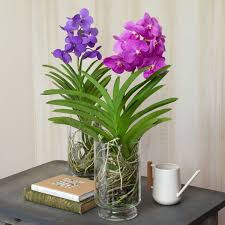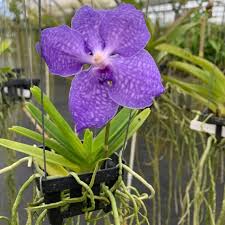Vanda Orchids, a mesmerizing group of flowering plants, are known for their stunning beauty and vibrant colors. These exotic flowers belong to the Orchidaceae family and can be found in various parts of the world, particularly in Southeast Asia. With their elegant appearance and unique characteristics, Vanda Orchids have captured the hearts of flower enthusiasts and collectors worldwide.
One of the most striking features of Vanda Orchids is their large and showy blossoms. The flowers come in a wide array of colors, ranging from brilliant blues, purples, and reds to softer pinks, yellows, and whites. Their petals often display intricate patterns and markings, adding to their allure. The blossoms are known to last for several weeks, making them a long-lasting and delightful addition to any floral arrangement or garden.
What sets Vanda Orchids apart from many other orchid species is their distinctive growth habit. They are epiphytes, which means they naturally grow on other plants or trees without being parasitic. In their natural habitats, they can be found clinging to tree branches, with their thick aerial roots absorbing moisture and nutrients from the air and rain. As a result, Vanda Orchids have adapted to thrive in various environments, including tropical forests and highland regions.
Caring for Vanda Orchids may seem challenging, but with the right knowledge and attention, they can thrive and reward their caretakers with breathtaking blooms. These orchids prefer bright but indirect light, and they should be protected from direct sunlight, which can scorch their delicate leaves. Proper air circulation is also essential for their well-being.
Vanda Orchids have unique water requirements. Instead of traditional potting soil, they are often grown in wooden baskets or containers filled with a coarse mix of materials like bark, charcoal, and sphagnum moss. This allows for excellent drainage, preventing waterlogged roots. Regular watering is necessary, but it’s vital to let the roots dry out between waterings to avoid root rot.
When it comes to temperature, Vanda Orchids thrive in warm to hot conditions, similar to their native tropical habitats. Nighttime temperatures should not drop drastically, as this can harm the plants. They also appreciate a slight drop in temperature during the winter, which can stimulate flower spikes.
Fertilizing Vanda Orchids is essential for maintaining their health and promoting blooming. A balanced orchid fertilizer should be used regularly, following the instructions provided by the manufacturer.
As with all living beings, Vanda Orchids may face certain challenges. Common issues include pests like aphids, mealybugs, and spider mites. Regularly inspecting the plants and promptly addressing any infestations can help keep these problems at bay.
In addition, Vanda Orchids are truly captivating flowers that have enchanted people for centuries. Their dazzling colors, unique growth habit, and graceful appearance make them stand out among other orchid species. While caring for them may require a bit of effort, the reward of witnessing their splendid blossoms is undoubtedly worth it. Whether you are a seasoned gardener or a beginner, growing Vanda Orchids is a delightful journey into the enchanting world of orchids.
Read Also: Popular Breeds of Ruminant Animals
Uses of Vanda Orchid Flowers

Vanda Orchids have a variety of uses, and their unique characteristics make them valuable in different areas. Here are some of the common uses of Vanda Orchids:
1. Ornamental Purposes: The primary use of Vanda Orchids is as ornamental plants. Their stunning and vibrant blooms make them popular choices for floral arrangements, bouquets, and decorative centerpieces. They add a touch of elegance and exotic beauty to any setting, whether it’s a formal event or a simple home decoration.
2. Landscaping and Gardens: Vanda Orchids can be incorporated into garden landscapes to create eye-catching displays. They can be grown in hanging baskets, wooden slats, or mounted on tree branches to showcase their aerial roots. In tropical and subtropical regions, they can be cultivated outdoors, adding a touch of tropical charm to gardens.
3. Cut Flowers: Vanda Orchids are often cut and used as long-lasting flowers in the cut flower industry. Due to their extended blooming period, they are favored for floral arrangements and bouquets, making them popular choices for special occasions and celebrations.
4. Hybridization and Breeding: Vanda Orchids are frequently used in hybridization programs to create new and unique orchid varieties. Horticulturists and enthusiasts cross different Vanda species to develop hybrids with desirable traits, such as enhanced colors, larger blooms, or more robust growth habits.
5. Medicinal and Cultural Uses: In some cultures, Vanda Orchids have been used for medicinal purposes. Traditional medicine in certain regions uses extracts from the flowers or other parts of the plant for various remedies. Additionally, Vanda Orchids hold cultural significance in some communities, where they are used in religious ceremonies and celebrations.
6. Perfumery and Fragrance Industry: Some Vanda Orchids, particularly those with highly fragrant blooms, are used in the perfume and fragrance industry. The exquisite scents of these orchids are extracted and incorporated into high-end perfumes and aromatic products.
7. Botanical Research and Education: Vanda Orchids, like other orchid species, are of interest to researchers, botanists, and educators. Studying their unique growth habits, pollination mechanisms, and adaptability to different environments can provide valuable insights into plant ecology and evolution.
8. Conservation and Biodiversity: As with many orchid species, some Vanda Orchids are endangered or threatened due to habitat loss and illegal collection. Conservation efforts aim to protect and preserve these species, often by cultivating them in controlled environments or botanical gardens.
In addition, Vanda Orchids have multiple uses beyond their aesthetic appeal. Whether it’s for ornamental purposes, breeding, research, or cultural significance, these exotic flowers continue to captivate people and contribute to various fields. As we appreciate their beauty, it’s essential to support conservation efforts to ensure their survival for future generations.
Read Also: The Ratio of a Male to Female Ruminants
Complete Growing and Care Guide of Vanda Orchid

Vanda Orchids are stunning and exotic flowering plants that can thrive in various environments if given the proper care and attention. Follow this comprehensive guide to successfully grow and care for Vanda Orchids:
1. Light:
Vanda Orchids require bright, indirect light to flourish. They thrive in bright, filtered sunlight, but direct sunlight can scorch their delicate leaves. East or west-facing windows with sheer curtains are excellent locations for indoor Vanda Orchids. Outdoors, they can be grown under shade cloth or in areas with filtered sunlight.
2. Temperature and Humidity:
Vanda Orchids prefer warm to hot temperatures, similar to their native tropical habitats. During the daytime, temperatures between 70°F to 95°F (21°C to 35°C) are ideal. At night, temperatures should not drop significantly, and they should not be exposed to temperatures below 60°F (15°C). High humidity is essential for their well-being, ideally between 50% to 80%. In dry climates, you can increase humidity by misting the orchids regularly or using a humidifier.
3. Watering:
Vanda Orchids have unique water requirements due to their epiphytic nature. They should never be planted in regular potting soil. Instead, they are typically grown in wooden baskets or containers with a coarse, well-draining medium like bark, charcoal, and sphagnum moss. Water the orchids thoroughly, allowing the water to flow freely through the medium and out the drainage holes. It’s crucial to let the roots dry out between waterings to prevent root rot. In warmer months, you may need to water them more frequently, but reduce watering during cooler periods.
4. Fertilizing:
Regular fertilizing is crucial to maintain the health and blooming of Vanda Orchids. Use a balanced orchid fertilizer that contains essential nutrients like nitrogen (N), phosphorus (P), and potassium (K). Dilute the fertilizer to half or quarter strength and apply it every two to four weeks during the growing season (spring and summer). Reduce or stop fertilizing during the dormant period in the fall and winter.
5. Potting and Repotting:
Vanda Orchids do not require regular repotting like other orchids. They can remain in their wooden baskets or containers for several years. However, if you notice the medium has broken down or the orchid has outgrown its pot, it’s time to repot. Gently remove the orchid from its current container, trim any damaged roots, and place it into a new basket or container with fresh orchid medium.
6. Air Circulation:
Vanda Orchids need good air circulation to prevent fungal and bacterial problems. Proper air movement helps the orchids dry quickly after watering, reducing the risk of root rot. Indoor fans or placing the orchids in locations with natural air movement can be beneficial.
7. Pruning:
Prune dead or damaged roots and spent flower spikes regularly. Removing spent flower spikes encourages the plant to produce new blooms and redirects energy into new growth.
8. Pests and Diseases:
Keep a close eye on your Vanda Orchids for signs of pests such as aphids, mealybugs, and spider mites. Regularly inspect the leaves, stems, and roots. If pests are detected, treat the orchids promptly with appropriate insecticides or natural remedies. Additionally, maintaining proper air circulation and avoiding overwatering can help prevent fungal and bacterial diseases.
By following these guidelines, you can provide your Vanda Orchids with the optimal conditions they need to thrive and produce their spectacular blossoms. With a little care and attention, these beautiful orchids will reward you with their breathtaking beauty and add a touch of exotic charm to your home or garden.
Read Also: Essential Teaching Courses for Professional Growth
